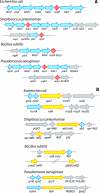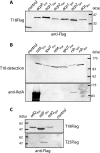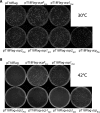Bacteria possessing two RelA/SpoT-like proteins have evolved a specific stringent response involving the acyl carrier protein-SpoT interaction
- PMID: 18996989
- PMCID: PMC2620808
- DOI: 10.1128/JB.01195-08
Bacteria possessing two RelA/SpoT-like proteins have evolved a specific stringent response involving the acyl carrier protein-SpoT interaction
Abstract
Bacteria respond to nutritional stress by producing (p)ppGpp, which triggers a stringent response resulting in growth arrest and expression of resistance genes. In Escherichia coli, RelA produces (p)ppGpp upon amino acid starvation by detecting stalled ribosomes. The SpoT enzyme responds to various other types of starvation by unknown mechanisms. We previously described an interaction between SpoT and the central cofactor of lipid synthesis, acyl carrier protein (ACP), which is involved in detecting starvation signals in lipid metabolism and triggering SpoT-dependent (p)ppGpp accumulation. However, most bacteria possess a unique protein homologous to RelA/SpoT (Rsh) that is able to synthesize and degrade (p)ppGpp and is therefore more closely related to SpoT function. In this study, we asked if the ACP-SpoT interaction is specific for bacteria containing two RelA and SpoT enzymes or if it is a general feature that is conserved in Rsh enzymes. By testing various combinations of SpoT, RelA, and Rsh enzymes and ACPs of E. coli, Pseudomonas aeruginosa, Bacillus subtilis and Streptococcus pneumoniae, we found that the interaction between (p)ppGpp synthases and ACP seemed to be restricted to SpoT proteins of bacteria containing the two RelA and SpoT proteins and to ACP proteins encoded by genes located in fatty acid synthesis operons. When Rsh enzymes from B. subtilis and S. pneumoniae are produced in E. coli, the behavior of these enzymes is different from the behavior of both RelA and SpoT proteins with respect to (p)ppGpp synthesis. This suggests that bacteria have evolved several different modes of (p)ppGpp regulation in order to respond to nutrient starvation.
Figures






Similar articles
-
Acyl carrier protein/SpoT interaction, the switch linking SpoT-dependent stress response to fatty acid metabolism.Mol Microbiol. 2006 Nov;62(4):1048-63. doi: 10.1111/j.1365-2958.2006.05442.x. Mol Microbiol. 2006. PMID: 17078815
-
Comparative genomics and evolution of genes encoding bacterial (p)ppGpp synthetases/hydrolases (the Rel, RelA and SpoT proteins).J Mol Microbiol Biotechnol. 2001 Oct;3(4):585-600. J Mol Microbiol Biotechnol. 2001. PMID: 11545276
-
Identification and functional analysis of novel (p)ppGpp synthetase genes in Bacillus subtilis.Mol Microbiol. 2008 Jan;67(2):291-304. doi: 10.1111/j.1365-2958.2007.06018.x. Epub 2007 Dec 7. Mol Microbiol. 2008. PMID: 18067544
-
Signalling by the global regulatory molecule ppGpp in bacteria and chloroplasts of land plants.Plant Biol (Stuttg). 2011 Sep;13(5):699-709. doi: 10.1111/j.1438-8677.2011.00484.x. Epub 2011 May 31. Plant Biol (Stuttg). 2011. PMID: 21815973 Review.
-
Magic spot: (p) ppGpp.J Cell Physiol. 2009 Aug;220(2):297-302. doi: 10.1002/jcp.21797. J Cell Physiol. 2009. PMID: 19391118 Review.
Cited by
-
Stringent response of Escherichia coli: revisiting the bibliome using literature mining.Microb Inform Exp. 2011 Dec 30;1(1):14. doi: 10.1186/2042-5783-1-14. Microb Inform Exp. 2011. PMID: 22587779 Free PMC article.
-
YtfK activates the stringent response by triggering the alarmone synthetase SpoT in Escherichia coli.Nat Commun. 2019 Dec 17;10(1):5763. doi: 10.1038/s41467-019-13764-4. Nat Commun. 2019. PMID: 31848343 Free PMC article.
-
Acyl Carrier Protein 3 Is Involved in Oxidative Stress Response in Pseudomonas aeruginosa.Front Microbiol. 2018 Sep 20;9:2244. doi: 10.3389/fmicb.2018.02244. eCollection 2018. Front Microbiol. 2018. PMID: 30294316 Free PMC article.
-
Regulation of francisella tularensis virulence.Front Microbiol. 2011 Jan 6;1:144. doi: 10.3389/fmicb.2010.00144. eCollection 2010. Front Microbiol. 2011. PMID: 21687801 Free PMC article.
-
Pleiotropic Effects of Bacterial Small Alarmone Synthetases: Underscoring the Dual-Domain Small Alarmone Synthetases in Mycobacterium smegmatis.Front Microbiol. 2020 Oct 14;11:594024. doi: 10.3389/fmicb.2020.594024. eCollection 2020. Front Microbiol. 2020. PMID: 33154743 Free PMC article. Review.
References
-
- Battesti, A., and E. Bouveret. 2006. Acyl carrier protein/SpoT interaction, the switch linking SpoT-dependent stress response to fatty acid metabolism. Mol. Microbiol. 621048-1063. - PubMed
-
- Battesti, A., and E. Bouveret. 2008. Improvement of bacterial two-hybrid vectors for detection of fusion proteins and transfer to PBAD-tandem affinity purification, calmodulin binding peptide, or 6-histidine tag vectors. Proteomics 84768-4771. - PubMed
-
- Cashel, M. 1994. Detection of (p)ppGpp accumulation patterns in Escherichia coli mutants. Methods Mol. Genet. 3341-356.
-
- Cashel, M., D. Gentry, V. J. Hernandez, and D. Vinella. 1996. The stringent response, p. 1458-1496. In F. C. Neidhardt, R. Curtiss III, J. L. Ingraham, E. C. C. Lin, K. B. Low, B. Magasanik, W. S. Reznikoff, M. Riley, M. Schaechter, and H. E. Umbarger (ed.), Escherichia coli and Salmonella: cellular and molecular biology. ASM Press, Washington, DC.
Publication types
MeSH terms
Substances
LinkOut - more resources
Full Text Sources
Molecular Biology Databases

